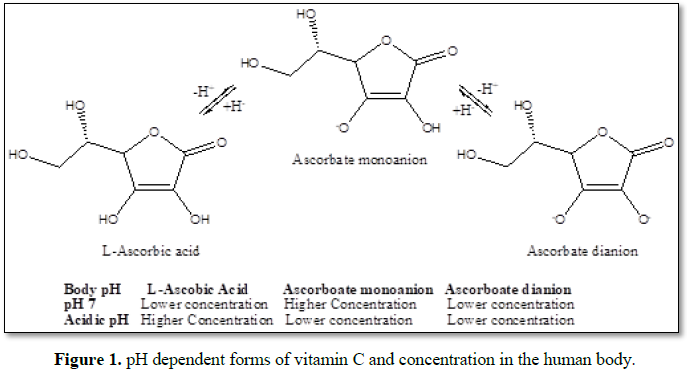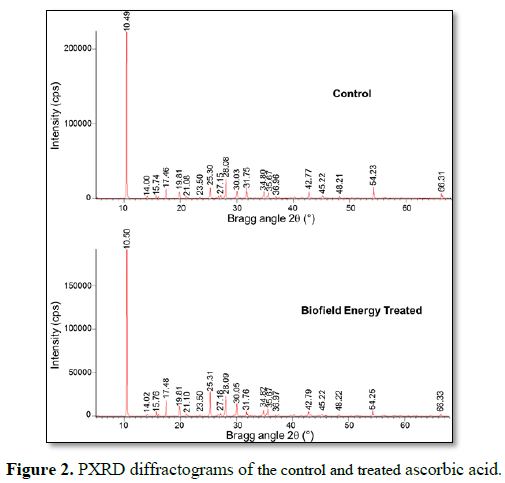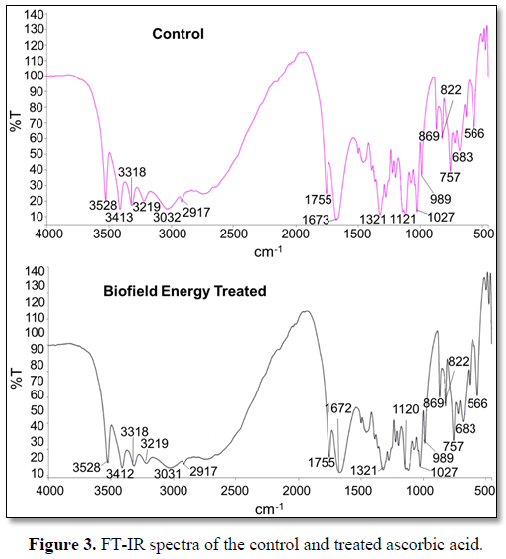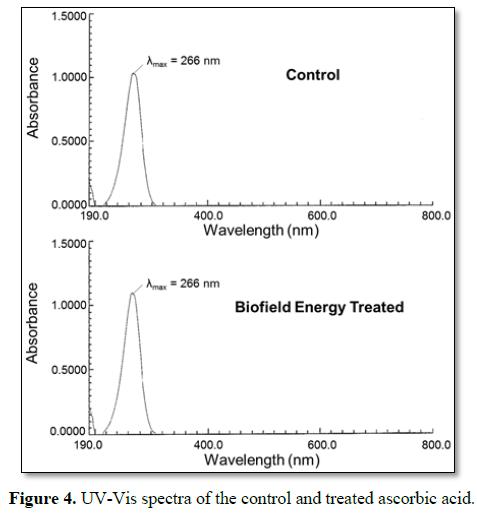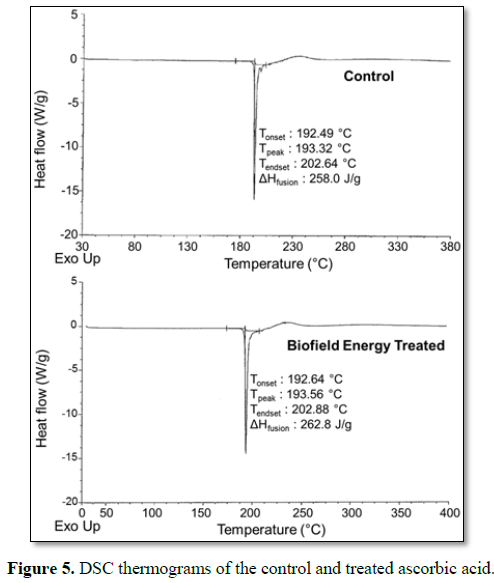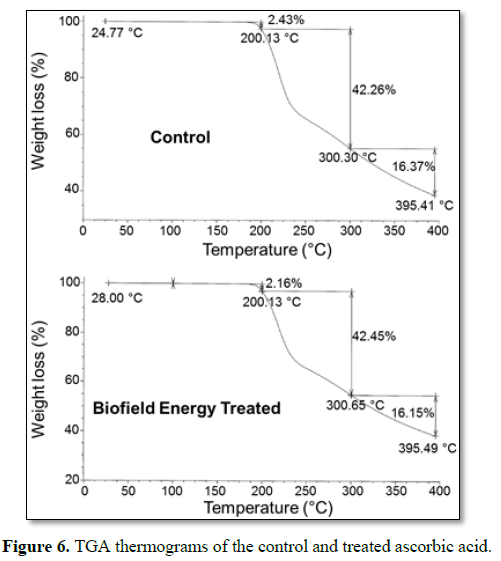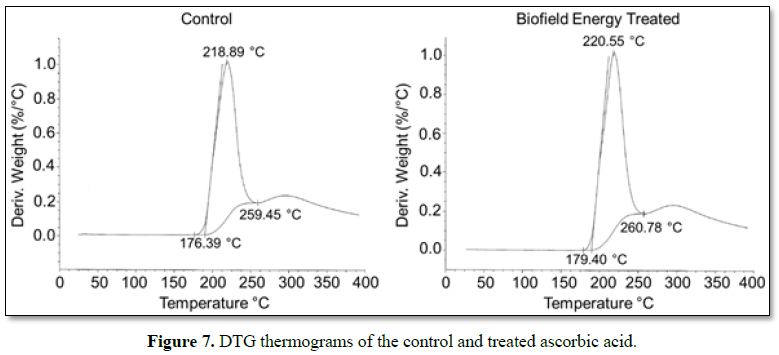768
Views & Citations10
Likes & Shares
Ascorbic acid (Vitamin C) acts as a cofactor for the enzymatic reactions
and performs numerous physiological functions in the human body. This study was
done with the objective to analyse the impact of the Trivedi Effect®-Consciousness
Energy Healing Treatment on the physicochemical, spectral and thermal
properties of ascorbic acid using various analytical techniques. In this
regard, the sample of ascorbic acid was divided into two parts and only one
part was received the Trivedi Effect®-Biofield Energy Healing
Treatment remotely by a renowned Biofield Energy Healer, Mr. Mahendra Kumar
Trivedi and termed as Biofield Energy Treated ascorbic acid. The PXRD relative
peak intensities and crystallite sizes of the treated ascorbic acid were
significantly altered ranging from -42.39% to 202.77% and -60.00% to 199.99%,
respectively compared with the control sample. However, the average crystallite
size of the treated ascorbic acid was significantly increased by 13.56%
compared with the control sample. The particle size of the treated ascorbic
acid values were significantly decreased by 26.46% (d10), 22.76% (d50),
30.47% (d90) and 27.12% {D(4,3)}, respectively; however, the surface
area was significantly increased by 35.58% compared with the control sample.
The melting point and latent heat of fusion (∆H) were increased by 0.12% and
1.86%, respectively in the treated ascorbic acid compared to the control
sample. The total weight loss was decreased, and maximum thermal degradation
temperature was increased in the treated ascorbic acid compared with the
control sample. The thermal analysis showed that the thermal stability of the
treated ascorbic acid was increased compared to the control sample. The Energy
of Consciousness Healing Treatment might have produced a new polymorphic form
of ascorbic acid, which would be more soluble, bioavailable, and thermally
stable compared with the untreated ascorbic acid. Thus, the Consciousness
Energy Healing Treated ascorbic acid would be very useful to design better
nutraceutical/pharmaceutical formulations which might offer better therapeutic
response against scurvy, cancer, obesity, cardiovascular diseases,
neurodegenerative and autoimmune diseases.
Keywords: Ascorbic acid, The
Trivedi Effect®, Biofield energy, Consciousness energy healing
treatment, PXRD, Particle size, DSC, TGA/DTG
INTRODUCTION
Vitamins are essential for
our health and are present in almost all the foods we consume. Currently, many
vitamin supplements such as multivitamin formulations are available for the
prevention and control of vitamin deficiency but also for the treatment of some
other diseases [1]. Ascorbic acid (L-ascorbic acid) also known as vitamin C (Figure
1). Foods that contain vitamin C include all the citrus fruit, tomatoes,
red peppers, potatoes, oysters, liver, milk, etc. [2,3]. It is required in a
range for the essential metabolic reactions in all plants and animals. Ascorbic
acid and ascorbate are both naturally present in the body and interconvert
according to pH when either of these is introduced into cells [4]. Ascorbic
acid can be found only at lower pH, but in neutral pH or above pH 5 is
predominantly found in the ionized form, ascorbate (Figure 1). Vitamin C
plays as a cofactor in the enzymatic reactions (i.e., hydroxylation and
amidation) and few non-enzymatic reactions.
It performs numerous
Vitamin C deficiency
leads to the various complications in the body, such as “scurvy” leads to the
bleeding gums, weakness, fatigue, brown spots on the skin (thighs and legs),
bruising, spongy gums and bleeding from all mucous membranes. Others symptoms associated
with less noticeable signs of vitamin C deficiency are still very serious such
as weak immune system, gingivitis, slow wound healing, dry and splitting hair,
nose bleeding, leaky gut, autoimmune disease, swollen and painful joints, etc.
Long term problems due to the low levels of vitamin C include the cancers, high
blood pressure, stroke, gallbladder disease, atherosclerosis, etc. [8-10].
Tolerable upper
intake level (UL) of vitamin C is 2,000 mg/day as per the Food and Nutrition
Board of the National Academy of Sciences. Relatively large doses of ascorbic
acid may cause indigestion, diarrhea, headache, flushing of the face, skin
rashes, fatigue, disturbed sleep, hemochromatosis, suppress the production of
progesterone from the corpus luteum in healthy subjects [3,13]. Low plasma
concentrations are testified in patients with diabetes and infections and in
smokers, but the contribution of diet and stress to these situations is
uncertain [14,15].
Some of the
limitations associated with vitamin C are its degradation during the packaging,
storage, and cooking of blended foods (maize, soya, etc.). Analytical study on
ascorbic acid (Lab grade), grape juice and vitamin C tablet (a pharmaceutical
product) confirmed that exposure to air and storage temperature condition
significantly affect the stability of the vitamin C so need to store under
refrigeration condition (4-5°C) [16]. Similarly, other scientific study
described that the loss of ascorbic acid following the first order kinetic
model and with 30.30% loss of vitamin C while processing at 70°C for 90 min in
fruit juice [17]. The stability is the major issue for vitamin C during
processing, storage, and cooking [15-17]. Physicochemical and thermal
properties of the pharmaceuticals play an important role of its absorption,
bioavailability as well as the stability [18] and to improve such parameters of
the pharmaceuticals is constant approach by the researcher. In this scenario,
it was observed that Biofield Energy Healing Treatment (the Trivedi Effect®)
is an economical approach and has considerable impact on the physicochemical
and thermal properties of pharmaceuticals and nutraceuticals, through the
possible mediation of neutrinos [19-22]. Every human body can discharge the
electromagnetic energy in the form of bio-photons, generated by the continuous
flow of the electrically charged particles inside the body, collectively known
as “Biofield Energy”. The Biofield Energy Healing practitioners have the
capability to harness the energy from the “Universal Energy Field” and can
transmit into any living or non-living object(s), this process is called
Biofield Energy Healing Treatment [23-25]. The Biofield based Energy Therapies
have been reported to with significant outcomes against various disease [26].
The National Center of Complementary and Integrative Health has recognized and
accepted Biofield Energy Healing as a Complementary and Alternative Medicine
health care approach in addition to other therapies, medicines and practices
such as yoga, Qi Gong, Tai Chi, hypnotherapy, healing touch, Reiki, etc. [27].
These therapies have been accepted by most of the U.S.A. population with
several advantages [28]. The Trivedi Effect®-Biofield Energy Healing
Treatment had been widely reported scientifically with significant outcome in
different fields of pharmaceuticals and nutraceuticals [19-21,29,30], organic
chemistry [31,32], materials science [33-35], agricultural science [36,37],
microbiology [38,39], cancer research [40,41], etc. Biofield Energy Healing
Treatment (the Trivedi Effect®) significantly improved the thermal
stability of some pharmaceuticals and nutraceuticals [17,19,28]. Thus, the
Trivedi Effect®-Biofield Energy Healing Treatment can be an
economical approach and solution to the practical issue like the thermal
stability of vitamin C and to improve other physicochemical parameters for
designing better pharmaceuticals and nutraceutical formulations. Therefore,
this study has been designed to evaluate the impact of the Trivedi Effect®
- Energy of Consciousness Healing Treatment on the physicochemical, thermal and
structural properties of ascorbic acid using modern analytical techniques.
MATERIALS AND METHODS
Chemicals and reagents
The test sample
ascorbic acid (Alfa Aesar) and other chemicals used during the experiments were
of analytical grade purchased in India.
Consciousness energy healing treatment
strategies
The sample of
ascorbic acid was divided into two parts. One part of ascorbic acid was
considered as a control sample, where no Biofield Energy Treatment was
provided. The second part of ascorbic acid was treated with the Trivedi Effect®
- Consciousness Energy Healing Treatment remotely under standard laboratory
conditions for 3 min by a renowned Biofield Energy Healer, Mr. Mahendra Kumar
Trivedi (USA) known as the Biofield Energy Treated ascorbic acid. The control
group was treated with a “sham” healer who did not have any knowledge about the
Biofield Energy Treatment. After that, the treatment, both the samples of
ascorbic acid were kept in sealed conditions and characterized using modern
analytical techniques.
Characterization
The powder X-ray
diffraction (PXRD) analysis of ascorbic acid powder sample was performed with
the help of PANalytical X’Pert3 Pro [19-21,42]. The average size of
crystallites was calculated from PXRD data using the Scherrer’s formula (1):
G
= kλ/βcosθ (1)
Where G is the
crystallite size in nm, k is the equipment constant (0.5), λ is the radiation
wavelength (0.154 nm for Kα1 emission), β is the full-width at half maximum and
θ is the Bragg angle [42,43].
The particle size
distribution (PSD) analysis was performed with the help of Malvern Mastersizer
3000, UK instrument and Mastersizer V3.50 software using the wet method
[19-21,42]. Fourier transform infrared (FT-IR) spectroscopy of ascorbic acid
was performed on Spectrum ES (Perkin Elmer, USA) Fourier transform infrared
spectrometer. Ultra violet-visible spectroscopy (UV-Vis) analysis was carried
out using Shimadzu UV-2400PC series, Japan. Similarly, the differential
scanning calorimetry (DSC) analysis of ascorbic acid was performed with the help
of DSC Q200, TA instruments. The thermal gravimetric analysis (TGA) thermograms
of ascorbic acid were obtained with the help of TGA Q50 TA instruments
[19-21,42].
The % change in
crystallite size, peak intensity, particle size, surface area, melting point,
latent heat, weight loss and the maximum thermal degradation temperature of the
Biofield Energy Treated ascorbic acid was calculated compared with the control
sample using the following equation 2:
% Change = [Treated –
Control] / Control × 100 (2)
RESULTS AND DISCUSSION
Powder X-ray diffraction (PXRD) analysis
The sharp and intense
peaks in PXRD diffractograms of the control and Biofield Energy Treated
ascorbic acid (Figure 2) indicating that both the samples were
crystalline in nature. PXRD data such as Bragg angle, relative intensity, and
crystallite size of the control and Biofield Energy Treated ascorbic acid are
presented in Table 1.
Similarly, the
crystallite size of the treated ascorbic acid was significantly altered ranging
from -60.00% to 199.99% compared to the control sample. Overall, the average
crystallite size of the Biofield Energy Treated ascorbic acid was significantly
increased by 13.56% compared to the control sample.
The relative peak
intensity of each diffraction face on the crystalline compound changes
according to the crystal morphology [44] and alterations in the XRD pattern
provide the proof of polymorphic transitions [45,46]. Changes in the
crystallite size and relative peak intensities of PXRD peaks revealed that the
crystal morphology of the Biofield Energy Treated ascorbic acid was altered
compared to the control sample. Thus, it can be anticipated that the decreased
in the crystallite size and relative peak intensities of the ascorbic acid were
due to the energy transferred through the Trivedi Effect®-Biofield
Energy Healing Treatment and this probably introduced a new polymorphic form of
ascorbic acid. Polymorphic forms of pharmaceuticals have the significant
effects on the drug performance, such as bioavailability, therapeutic efficacy
and toxicity, because of their thermodynamic and physicochemical properties
like melting point, energy, stability and especially solubility, are different
(probably improvement) from the original form [47,48]. Thus, it can be
anticipated that Mr. Trivedi’s Biofield Energy Treatment (the Trivedi Effect®)
could be a very useful technique for the production of novel crystal polymorph of
ascorbic acid that would improve the bioavailability and its therapeutic
performance.
Particle size distribution (PSD) analysis
Particle size values
of the control and Biofield Energy Treated ascorbic acid were investigated and
the results are presented in Table 2. The particle size values in the
Biofield Energy Treated ascorbic acid at d10, d50, d90
and D(4,3) was significantly decreased by 26.46%, 22.76%, 30.47% and 27.12%,
respectively compared to the control sample. Consequently, the surface area of
the control and Biofield Energy Treated ascorbic acid were 66.39 m2/g
and 90.01 m2/g, respectively. The surface area of the Biofield
Energy Treated ascorbic acid was significantly increased by 35.58% compared
with the control sample.
The particle size and
surface area of the pharmaceuticals play a vital role in the solubility, absorption,
dissolution and bioavailability [49-51]. Smaller the particle size and higher
surface area enhance the solubility of the solid particles as well as increase
the dissolution rate and bioavailability [51,52]. Thus, it is anticipated that
the Trivedi Effect® - Energy of Consciousness Healing Treated
ascorbic acid might be absorbed in faster rate from the gut and thus, may offer
better bioavailability compared to the control sample.
Fourier transform infrared (FT-IR) spectroscopy
The FT-IR spectra of
the control and Biofield Energy Treated ascorbic acid showed the clear
stretching and bending peak in the functional group and fingerprint region (Figure
3). The strong peaks in the functional group region of both control and
Biofield Energy Treated spectra were observed near 3528-3032 cm-1
may be due to O-H stretching frequency due to the primary and secondary alcohol
present in the structure of ascorbic acid. The broad FT-IR band near 2917 cm-1
was definitely C-H stretching bands of both the samples. Very intensive peaks
near 1755 cm-1 in the spectra of the control and Biofield Energy
Treated samples were the results of stretching vibration bands of C=O of the
carbonyl group. The spectra showed aliphatic C=C stretching at 1673 cm-1
for the samples. It showed the C-O and C-C stretching frequency at 1121 and
1027 cm-1, respectively for both the samples of Ascorbic Acid. The
FT-IR spectra did not display any changes in the vibrational frequencies. The
experimental FT-IR data of the control and Biofield Energy Treated samples were
matched with the reported values of ascorbic acid [53]. The fingerprint and
functional group region of the Biofield Energy treated ascorbic acid was
remained the same compared to the control sample. Overall FT-IR results
suggested that there was no significant alteration in the structural properties
of the Biofield Energy Treated ascorbic acid compared to the control sample.
Ultraviolet-visible spectroscopy (UV-Vis)
analysis
The UV-visible
spectra of the control and Biofield Energy Treated ascorbic acid are shown in Figure
4. The UV spectrum of control and Biofield Energy Treated ascorbic acid
showed the maximum absorbance at 266 nm (λmax). UV absorption of
ascorbic acid in water solution is 266 nm according to the literature Selimovic
et al. [54], which was well correlated with the experimental results. The peak
at 266 nm was showed a minor shift of absorbance maxima from 1.0335 in control
to 1.0948 in the Biofield Energy treated ascorbic acid. Thus, no significant
difference was found in the absorbance maxima between the control and Biofield
Energy treated samples.
Differential scanning calorimetry (DSC)
analysis
The DSC thermograms
of the control and Biofield Energy treated samples of ascorbic acid exhibited a
sharp endothermic peak at 193.32 and 193.56°C, respectively, which was due to
the melting temperature of ascorbic acid (Figure 5). The experimental
data are well correlated with the published literature data [55]. The results
suggested that the melting temperature of the Biofield Energy treated ascorbic
acid was increased by 0.12% compared to the control sample (Table 3).
Similarly, the latent heat of fusion (∆H) in the Biofield Energy treated
(262.80 J/g) ascorbic acid was increased by 1.86% compared to the control
(258.00 J/g) sample (Table 3). The DSC data concluded that the thermal
stability of the ascorbic acid was increased after the Biofield Energy
treatment.
Thermal gravimetric analysis (TGA)
The TGA thermograms
of the control and Biofield Energy Treated ascorbic acid exhibited three steps
of thermal degradation (Figure 6). The experimental data are well
correlated with the published literature data [55]. The weight loss of each
step was calculated for both the samples and tabulated in Table 4. The
percentage weight loss in the 1st and 3rd steps of
degradation of the Biofield Energy Treated ascorbic acid was significantly
decreased by 12.80% and 1.36%, while in the 2nd step of degradation
was slightly increased by 0.45% compared with the control sample (Table 4).
The total weight loss in the Biofield Energy Treated ascorbic acid was
decreased by 0.50% compared with the control sample.
The DTG thermograms
of the control and Biofield Energy Treated ascorbic acid (Figure 7)
revealed maximum thermal degradation temperature (Tmax) at 218.89°C
and 220.55°C, respectively. The DTG analysis indicated that the maximum thermal
decomposition temperature of the Biofield Energy Treated ascorbic acid was
increased by 0.76% compared with the control sample (Table 4). Overall,
thermal analysis (DSC, TGA/DTG) revealed that the thermal stability of the
Biofield Energy Treated ascorbic acid was increased compared to the control
sample.
CONCLUSION
Overall experimental
results revealed that the Trivedi Effect® - Consciousness Energy
Healing Treatment has a significant impact on the physicochemical and thermal
properties of ascorbic acid. The relative peak intensities and crystallite
sizes of the Biofield Energy Treated ascorbic acid were significantly altered
ranging from -42.39% to 202.77% and -60.00% to 199.99%, respectively compared
to the control sample. However, the average crystallite size of the treated
ascorbic acid was significantly increased by 13.56% compared with the control
sample. The particle size of the treated ascorbic acid were significantly
decreased by 26.46% (d10), 22.76% (d50), 30.47% (d90)
and 27.12% {D(4,3)}, respectively compared with the control sample. Thus, the
surface area of the treated ascorbic acid was significantly increased by 35.58%
compared with the control sample. The melting point and ∆Hfusion
were increased in the treated ascorbic acid compared to the control sample. The
total weight loss was decreased and the maximum thermal degradation temperature
was increased in the treated ascorbic acid compared with the control sample.
Overall, the thermal analysis indicated that the thermal stability of the
Biofield Energy Treated ascorbic acid was increased compared to the control
sample. The Energy of Consciousness Healing Treatment might have produced a new
polymorphic form of ascorbic acid, which would be more soluble, bioavailable,
and thermally stable compared with the untreated ascorbic acid. The Biofiel
Energy treated ascorbic acid would be very useful to design better
nutraceutical/pharmaceutical formulations which might offer better therapeutic
response against scurvy, cancer, obesity, cardiovascular diseases (myocardial
infarction, stroke, etc.), hypertension, neurodegenerative diseases
(Alzheimer's disease), autoimmune diseases (rheumatoid arthritis), etc.
ACKNOWLEDGEMENT
The authors are
grateful to GVK Biosciences Pvt. Ltd., Trivedi Science, Trivedi Global, Inc.,
Trivedi Testimonials and Trivedi Master Wellness for their assistance and
support during this work.
1. Chen
Z, Chen B, Yao S (2006) High-performance liquid chromatography/electrospray
ionization-mass spectrometry for simultaneous determination of taurine and 10
water-soluble vitamins in multivitamin tablets. Anal Chim Acta 569: 169-175.
2. (2017)
Fact sheet for health professionals - Vitamin C. Office of Dietary Supplements,
US National Institutes of Health. Retrieved on 07 June 2017.
3. https://www.en.wikipedia.org/wiki/Vitamin_C
4. Figueroa-Méndez
R, Rivas-Arancibia S (2015) Vitamin C in health and disease: Its role in the
metabolism of cells and redox state in the brain. Front Physiol 6.
5. Padayatty
SJ, Katz A, Wang Y, Eck P, Kwon O, et al. (2003) Vitamin C as an antioxidant:
Evaluation of its role in disease prevention. J Am Coll Nutr 22: 18-35.
6. Meister
A (1994) Glutathione-ascorbic acid antioxidant system in animals. J Biol Chem
269: 9397-9400.
7. Valko
M. Leibfritz D, Moncol J, Cronin MT, Mazur M, et al. (2007) Free radicals and
antioxidants in normal physiological functions and human disease. Int J Biochem
Cell Biol 39: 44-84.
8. Chen
Q, Espey MG, Krishna MC, Mitchell JB, Corpe CP, et al. (2005) Pharmacologic
ascorbic acid concentrations selectively kill cancer cells: Action as a
pro-drug to deliver hydrogen peroxide to tissue. Proc Natl Acad Sci U S A 102:
13604-13609.
9. Ye Y,
Li J, Yuan Z (2013) Effect of antioxidant vitamin supplementation on
cardiovascular outcomes: A meta-analysis of randomized controlled trials. PLoS
One 8: e56803.
10. Chen
GC, Lu DB, Pang Z, Liu QF (2013) Vitamin C intake, circulating vitamin C and
risk of stroke: A meta-analysis of prospective studies. J Am Heart Assoc 2:
e000329.
11. Li
FJ, Shen L, Ji HF (2012) Dietary intakes of vitamin E, vitamin C and β-carotene
and risk of Alzheimer's disease: A meta-analysis. J Alzheimers Dis 31: 253-258.
12. Rosenbaum
CC, O'Mathúna DP, Chavez M, Shields K (2010) Antioxidants and anti-inflammatory
dietary supplements for osteoarthritis and rheumatoid arthritis. Altern Ther
Health Med 16: 32-40.
13. Institute
of Medicine (2000) Dietary reference intakes for Vitamin C, Vitamin E, selenium
and carotenoids. Washington, DC: The National Academies Press, pp: 95-185.
14. World
Health Organization (1974) Toxicological evaluation of some food additives
including anticaking agents, antimicrobials, antioxidants, emulsifiers and
thickening agents. 17th Report, World Health Organization: Geneva.
15. (2001)
Human vitamin and mineral requirements. Chapter 6. Food and Nutrition Division,
FAO Rome, Italy.
16. Oyetade
OA, Oyeleke GO, Adegoke BM, Akintunde AO (2012) Stability studies on ascorbic
acid (Vitamin C) from different sources. IOSR J Appl Chem 2: 20-24.
17. Paul
R, Ghosh U (2012) Effect or thermal treatment on ascorbic content of
pomegranate juice. Indian J Biotechnol 11: 309-312.
18. Chereson
R (2009) Bioavailability, bioequivalence and drug selection. In: Makoid CM,
Vuchetich PJ, Banakar UV (Eds) Basic pharmacokinetics (1st Edn)
Pharmaceutical Press, London.
19. Trivedi
MK, Branton A, Trivedi D, Nayak G, Ellis MP, et al. (2017) Effect of the energy
of consciousness (the Trivedi Effect®) on physicochemical, thermal,
structural and behavioral properties of magnesium gluconate. Chem Biomol Eng 2:
113-123.
20. Trivedi
MK, Branton A, Trivedi D, Nayak G, Lee AC, et al. (2017) Impact of
consciousness energy healing treatment (the Trivedi Effect®) on
physical, spectroscopic and thermal properties of Withania somnifera (ashwagandha) root extract. Int J Food Sci
Biotechnol 2: 6-15.
21. Trivedi
MK, Branton A, Trivedi D, Nayak G, Nykvist CD, et al. (2017) Evaluation of the
Trivedi Effect®- Energy of consciousness energy healing treatment on
the physical, spectral and thermal properties of zinc chloride. Am J Life Sci
5: 11-20.
22. Trivedi
MK, Mohan TRR (2016) Biofield energy signals, energy transmission and
neutrinos. Am J Modern Phys 5: 172-176.
23. Rubik
B (2002) The biofield hypothesis: Its biophysical basis and role in medicine. J
Altern Complement Med 8: 703-717.
24. Nemeth
L (2008) Energy and biofield therapies in practice. Beginnings 28: 4-5.
25. Rivera-Ruiz
M, Cajavilca C, Varon J (2008) Einthoven's string galvanometer: The first
electrocardiograph. Tex Heart Inst J 35: 174-178.
26. Rubik
B, Muehsam D, Hammerschlag R, Jain S (2015) Biofield science and healing:
history, terminology and concepts. Glob Adv Health Med 4: 8-14.
27. Koithan
M (2009) Introducing complementary and alternative therapies. J Nurse Pract 5:
18-20.
28. Barnes
PM, Bloom B, Nahin RL (2008) Complementary and alternative medicine use among adults
and children: United States, 2007. Natl Health Stat Rep 12: 1-23.
29. Trivedi
MK, Branton A, Trivedi D, Shettigar H, Bairwa K, et al. (2015) Fourier
transform infrared and ultraviolet-visible spectroscopic characterization of
biofield treated salicylic acid and sparfloxacin. Nat Prod Chem Res 3: 186.
30. Trivedi
MK, Branton A, Trivedi D, Nayak G, Nykvist CD, et al. (2017) Evaluation of the
physicochemical, spectral and thermal properties of sodium selenate treated
with the energy of consciousness (the Trivedi Effect®). Adv Biosci
Bioeng 5: 12-21.
31. Trivedi
MK, Branton A, Trivedi D, Nayak G, Sethi KK, et al. (2016) Determination of
isotopic abundance ratio of biofield energy treated 1,4-dichlorobenzene using
gas chromatography-mass spectrometry (GC-MS). Modern Chem 4: 30-37.
32. Trivedi
MK, Branton A, Trivedi D, Nayak G, Sethi KK, et al. (2016) Isotopic abundance
ratio analysis of biofield energy treated indole using gas chromatography-mass
spectrometry. Sci J Chem 4: 41-48.
33. Trivedi
MK, Tallapragada RM, Branton A, Trivedi D, Nayak G, et al. (2015)
Physicochemical characterization of biofield energy treated calcium carbonate
powder. Am J Health Res 3: 368-375.
34. Trivedi
MK, Tallapragada RM, Branton A, Trivedi D, Nayak G, et al. (2015) Potential
impact of biofield treatment on atomic and physical characteristics of
magnesium. Vitam Miner 3: 129.
35. Trivedi
MK, Tallapragada RM, Branton A, Trivedi D, Nayak G, et al. (2015)
Characterization of physical and structural properties of aluminum carbide
powder: Impact of biofield treatment. J Aeronaut Aerospace Eng 4: 142.
36. Trivedi
MK, Branton A, Trivedi D, Nayak G, Gangwar M, et al. (2016) Molecular analysis
of biofield treated eggplant and watermelon crops. Adv Crop Sci Tech 4: 208.
37. Trivedi
MK, Branton A, Trivedi D, Nayak G, Mondal SC, et al. (2015) Evaluation of plant
growth, yield and yield attributes of biofield energy treated mustard (Brassica juncea) and chick pea (Cicer arietinum) seeds. Agric Forestry
Fisheries 4: 291-295.
38. Trivedi
MK, Patil S, Shettigar H, Mondal SC, Jana S (2015) An impact of biofield
treatment: Antimycobacterial susceptibility potential using BACTEC 460/MGIT-TB
System. Mycobact Dis 5: 189.
39. Trivedi
MK, Patil S, Shettigar H, Mondal SC, Jana S (2015) Evaluation of biofield
modality on viral load of hepatitis B and C Viruses. J Antivir Antiretrovir 7:
083-088.
40. Trivedi
MK, Patil S, Shettigar H, Mondal SC, Jana S (2015) The potential impact of
biofield treatment on human brain tumor cells: A time-lapse video microscopy. J
Integr Oncol 4: 141.
41. Trivedi
MK, Patil S, Shettigar H, Gangwar M, Jana S (2015) In vitro evaluation of biofield treatment on cancer biomarkers
involved in endometrial and prostate cancer cell lines. J Cancer Sci Ther 7:
253-257.
42. Trivedi
MK, Sethi KK, Panda P, Jana S (2017) Physicochemical, thermal and spectroscopic
characterization of sodium selenate using XRD, PSD, DSC, TGA/DTG, UV-Vis and
FT-IR. Marmara Pharm J 21/2: 311-318.
43. Langford
JI, Wilson AJC (1978) Scherrer after sixty years: A survey and some new results
in the determination of crystallite size. J Appl Cryst 11: 102-113.
44. Inoue
M, Hirasawa I (2013) The relationship between crystal morphology and XRD peak
intensity on CaSO4.2H2O. J Crystal Growth 380: 169-175.
45. Raza
K, Kumar P, Ratan S, Malik R, Arora S (2014) Polymorphism: The phenomenon
affecting the performance of drugs. SOJ Pharm Pharm Sci 1: 10.
46. Brittain
HG (2009) Polymorphism in pharmaceutical solids in drugs and pharmaceutical
sciences. 2nd Edn. Informa Healthcare USA, Inc., New York 192.
47. Censi
R, Martino PD (2015) Polymorph impact on the bioavailability and stability of
poorly soluble drugs. Molecules 20: 18759-18776.
48. Blagden
N, de Matas M, Gavan PT, York P (2007) Crystal engineering of active
pharmaceutical ingredients to improve solubility and dissolution rates. Adv
Drug Deliv Rev 59: 617-630.
49. Chereson
R (2009) Bioavailability, bioequivalence and drug selection. In: Makoid CM,
Vuchetich PJ, Banakar UV (Eds) Basic pharmacokinetics (1st Edn)
Pharmaceutical Press, London.
50. Khadka
P, Ro J, Kim H, Kim I, Kim JT, et al. (2014) Pharmaceutical particle
technologies: An approach to improve drug solubility, dissolution and
bioavailability. Asian J Pharm Sci 9: 304-316.
51. Mosharrof
M, Nystrӧm C (1995) The effect of particle size and shape on the surface
specific dissolution rate of microsized practically insoluble drugs. Int J
Pharm 122: 35-47.
52. Buckton
G, Beezer AE (1992) The relationship between particle size and solubility. Int
J Pharm 82: R7-R10.
53. Hvoslef
J, Klaeboe P (1971) Vibrational spectroscopic studies of L-ascorbic acid and
sodium ascorbate. Acta Chem Scand 25: 3043-3053.
54. Selimović
A, Salkić M, Selimović A (2011) Direct spectrophotometric determination of
L-ascorbic acid in pharmaceutical preparations using sodium oxalate as a
stabilizer. Int J Basic Appl Sci 11: 106-109.
55. Reda
SY (2011) Evaluation of antioxidants stability by thermal analysis and its
protective effect in heated edible vegetable oil. Ciênc Tecnol Aliment 31:
475-480.

